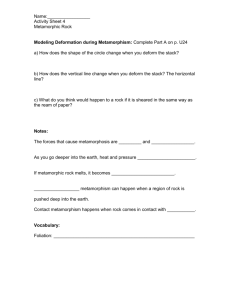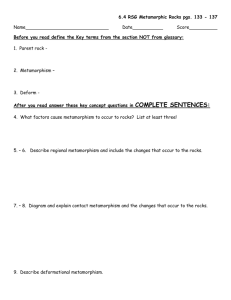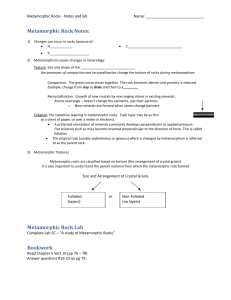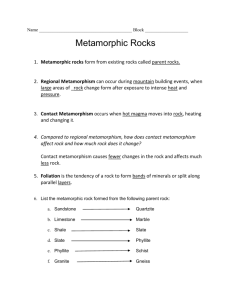File
advertisement
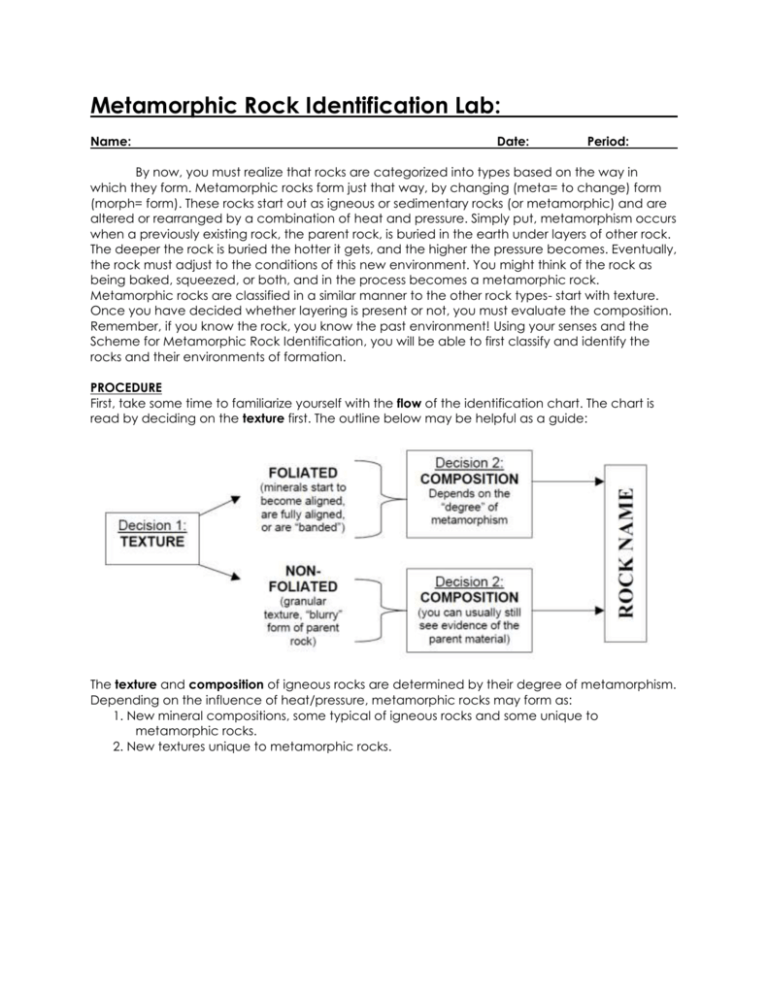
Metamorphic Rock Identification Lab: Name: Date: Period: By now, you must realize that rocks are categorized into types based on the way in which they form. Metamorphic rocks form just that way, by changing (meta= to change) form (morph= form). These rocks start out as igneous or sedimentary rocks (or metamorphic) and are altered or rearranged by a combination of heat and pressure. Simply put, metamorphism occurs when a previously existing rock, the parent rock, is buried in the earth under layers of other rock. The deeper the rock is buried the hotter it gets, and the higher the pressure becomes. Eventually, the rock must adjust to the conditions of this new environment. You might think of the rock as being baked, squeezed, or both, and in the process becomes a metamorphic rock. Metamorphic rocks are classified in a similar manner to the other rock types- start with texture. Once you have decided whether layering is present or not, you must evaluate the composition. Remember, if you know the rock, you know the past environment! Using your senses and the Scheme for Metamorphic Rock Identification, you will be able to first classify and identify the rocks and their environments of formation. PROCEDURE First, take some time to familiarize yourself with the flow of the identification chart. The chart is read by deciding on the texture first. The outline below may be helpful as a guide: The texture and composition of igneous rocks are determined by their degree of metamorphism. Depending on the influence of heat/pressure, metamorphic rocks may form as: 1. New mineral compositions, some typical of igneous rocks and some unique to metamorphic rocks. 2. New textures unique to metamorphic rocks. Metamorphic Rock Number Foliated or Non-Foliated Metamorphic Rock Name USE THE EARTH SCIENCE REFERENCE TABLES AT THE BEGINNING OF YOUR NOTEBOOK TO ANSWER: 1. Determine the name of a metamorphic rock that is foliated, HAD some mica which has changed into feldspar, and has medium to coarse grain size_______________. 2. There is one metamorphic rock with variable composition, it is nonfoliated and forms from contact metamorphism, it is __________________. 3. Part of its name comes from a sedimentary rock formed from glacier deposits, it is formed by regional or contact metamorphism. This rock is __________________________. 4. Another metamorphic rock with composition similar to a mineral AND a bioclastic sedimentary rock, also bubbles with acid, and is non-foliated. Name it _____________. 5. This silicate based metamorphic rock is non-foliated with fine to coarse grain size. It is known by the name__________________. 6. A foliated rock showing mineral alignment and formed from regional metamorphism. It can contain mica, feldspar, quartz, garnet and amphibole. The ESRT names it ____________________ 7. With a fine grain size, it has undergone regional metamorphism, it can split easily into flat surfaces partly due to its mica content. You should call it ________________. 8. All metamorphic rocks are formed by one of two general types of metamorphism, these are_________________________ and _________________________ metamorphism 9. This rock shows a kind of foliation described as ‘mineral alignment’ and does not contain pyroxene; ___________________ 10. How does contact metamorphism change rocks? 11. This metamorphic rock can have various mineral particles in it, and does have a coarse grain size with particles in a matrix. It is also called ______________________. 12. One particular specimen starts as a clastic sedimentary rock with a grain size of 0.04 cm called _____________________. It undergoes metamorphosis to become ___________ 13. Name 5 minerals that can be found in schist a. ____________________ d. ____________________ b. ____________________ e. ____________________ c. ____________________ 14. What other metamorphic rock also has the above 5 minerals in it? ______________________ 15. Is there a metamorphic rock, that is foliated, has a fine texture, composed mainly of mica and is formed from contact metamorphism? Yes or No (circle answer) 16. Metamorphic rock texture is described by two major characteristics. Metamorphic rocks are either __________________ or ________________________.




